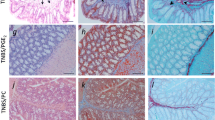Abstract
The majority of intra-abdominal adhesions develop postoperatively or following peritonitis. We have previously shown thatl-phosphatidylcholine reduces postoperative peritoneal adhesions in rats. In the present study, we examined whether adhesion formation after bacterial peritonitis is also reduced byl-phosphatidylcholine or bydl-α-phosphatidylcholine, which is degraded only 50% by phospholipase A2. Peritonitis was induced in the rat by caecal ligation and double puncture; cecotomy was performed 12, 15, or 18h later. Adhesions were assessed blindly by a scoring system 7 days after cecotomy. When cecotomy was scheduled for 18h after caecal ligation and puncture, the 7-day mortality was 90% (n=20). When cecotomy was performed at 12h, no mortality was seen; however, the adhesion score was low (2.3±0.7). When cecotomy was performed 15h after caecal ligation and puncture, the mortality was 25% and the adhesion score was 4.3±0.9. This figure was reduced significantly by intraperitoneal instillation ofl-phosphatidylcholine ordl-α-phosphatidylcholine for 3 subsequent days. However, the mortality increased byl-phosphatidylcholine (P<0.01), whereas mortality afterdl-α-phosphatidylcholine remained at 30%. We conclude that administration of bothl-phosphatidylcholine anddl-α-phosphatidylcholine decrease adhesion formation after bacterial peritonitis.
Similar content being viewed by others
References
Almdahl SM, Nordstrand K, Melby K, Osterud B, Gierecky KE (1985) Faecal peritonitis in the rat. Acta Chir Scand 151:213–216
Ar'Rajab A, Ahrén B, Rozga J, Bengmark S (1991) Phosphatidylcholine prevents post-operative peritoneal adhesions. J Surg Res 50:212–215
Bartlett JG, Onderdonk AB, Louie T, et al (1978) Lessons from an animal model of intraabdominal sepsis. Arch Surg 113:853–857
Brolin J, Lahnborg G, Nord CE (1984) The effect of one prophylactic dosage of antibiotics on experimentally induced lethal intra-abdominal sepsis. Acta Chir Scand 150:239–244
Chalkiadakis GE, Kostakis A, Karydakis P, et al (1985) Effect of aprotinin on fibropurulent peritonitis in rats. Am J Surg 150:550–553
Chang J, Musser JH, McGregor H (1987) Phospholipase A2: function and pharmacologic regulation. Biochem Pharmacol 36:2429–2436
Chi LM, Wu WG, Sung KLP, Chien S (1990) Biophysical correlates of lysophosphatidylcholine-and ethanol-mediated shape transformation and hemolysis of human erythrocytes. Membrane viscoelasticity and NMR measurement. Biochim Biophys Acta 1027:163–171
Ellis H (1971) The cause and prevention of postoperative intraperitoneal adhesions. Surg Gynecol Obstet 133:497–510
Garcia MC, Fernandez-Gallardo S, Gijon MA, Garcia C, Nieto ML, Sanchez-Crespo M (1990) Biosynthesis of platelet-activating factor (PAF) in human polymorphonuclear leukocytes. Biochem J 268:91–98
Grahame GR, Torchia MG, Dakewich KA, Ferguson IA (1985) Surface active material in peritoneal effuent of CAPD patients. Bull Periton Dial 5:109–111
Hazed LA, Stuppy RJ, Gross RW (1990) Purification and characterisation of canine myocardial cytosoloic phospholipase A2. J Biol Chem 266:10622–10630
Holtz G (1984) Prevention and management of peritoneal adhesions. Fertil Steril 41:497–507.
Menzies D, Ellis H (1990) Intestinal obstruction from adhesions-how big is the problem? Ann R Coll Surg Engl 172:60–63
O'Leary JP, Wickbom G, Cha SO, Wickborn A (1987) The role of faeces, necrotic tissue, and various blocking agents in the prevention of adhesions. Ann Surg 207:693–698
Snoj M, Ar'Rajab A, Ahrén B, Bengmark S (1992) Phosphatidylcholine prevents postoperative adhesion formation after small bowel anastomosis in the rat. Br J Surg (in press)
Van Deenen LLM, De Haas GH (1963) The substrate specificity of phospholipase A. Biochim Biophys Acta 70:538–553
Weibel MA, Majno G (1973) Peritoneal adhesions and their relation to abdominal surgery. Am J Surg 126:345–353
Wichterman KA, Baue AE, Chaudry IH (1980) Sepsis and septic shock—a review of laboratory models and proposal. J Surg Res 29:189–201
Wright GW, Ooi CE, Weiss J, Elsbach P (1990) Purification of a cellular (granulocyte) and extracellular (serum) phospholipase A2 that participate in the destruction of E. coli in rabbit inflammatory exudate. J Biol Chem 265:6675–6681
Author information
Authors and Affiliations
Rights and permissions
About this article
Cite this article
Snoj, M., Ar'Rajab, A., Ahrén, B. et al. Phospholipase-resistant phosphatidylcholine reduces intra-abdominal adhesions induced by bacterial peritonitis. Res. Exp. Med. 193, 117–122 (1993). https://doi.org/10.1007/BF02576218
Received:
Accepted:
Issue Date:
DOI: https://doi.org/10.1007/BF02576218




